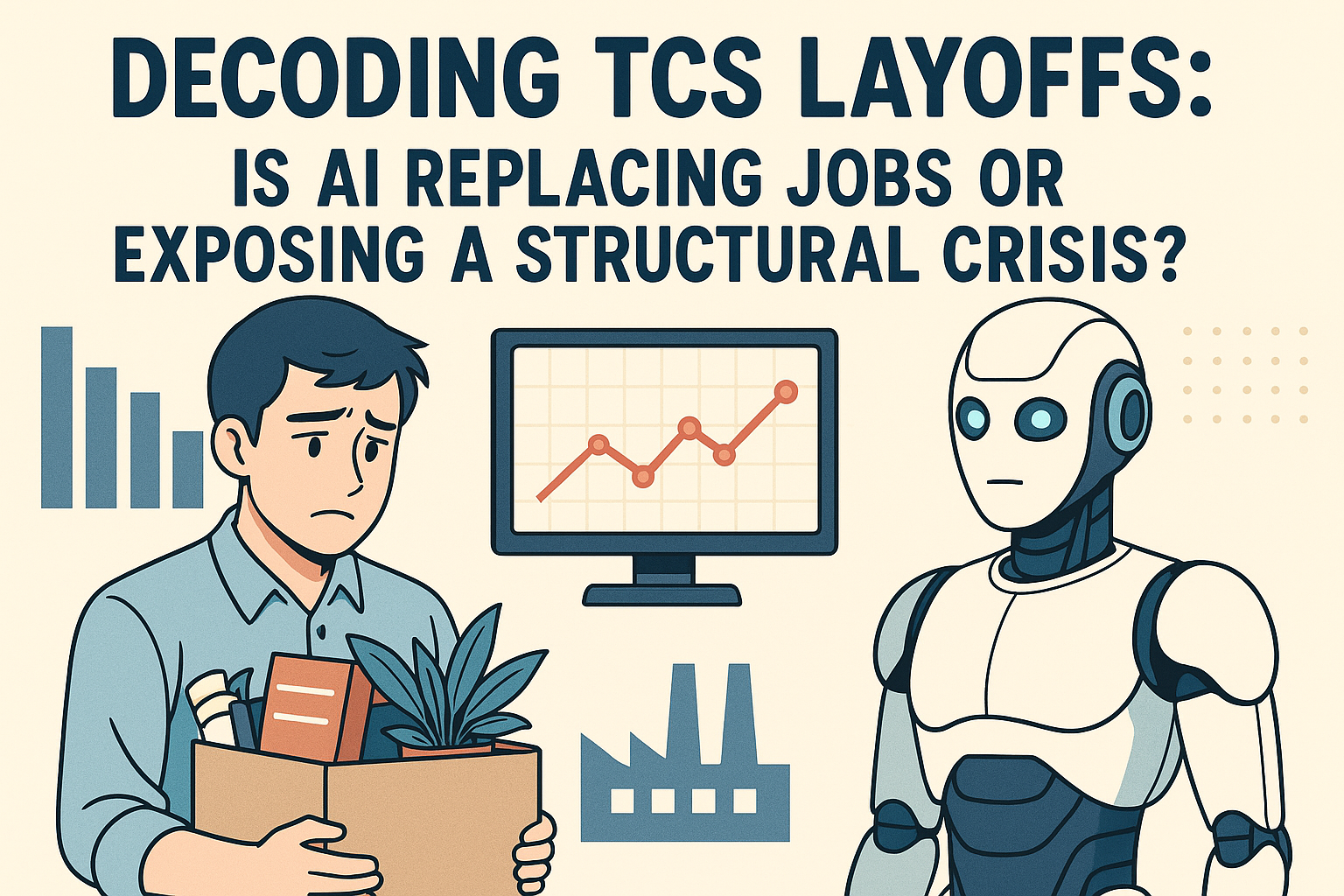TCS plans to lay off 12,000 employees—just 2% of its workforce—but the impact is symbolic of deeper structural issues. Is AI really the reason, or are cost pressures and a broken management pyramid more to blame? This article investigates.
WHO: Who's Being Affected?
- The 12,000 layoffs target mostly mid-level managers and experienced professionals—people earning higher salaries.
- TCS calls it a "reskilling and redeployment initiative", but insiders see it as the quiet displacement of traditional roles by tech efficiency.
- Those in scheduling, coordination, documentation, and reporting are most vulnerable—roles increasingly automated by AI tools.
The layoffs are not limited to any one domain. Employees across departments like finance, operations, client servicing, and software project management are being shown the door. Ironically, many of these individuals have been the backbone of the TCS ecosystem for years.
WHAT: What’s Actually Happening?
- Officially, TCS claims this is not about AI. They cite "streamlining for cost-efficiency" and "skill mismatches".
- The company is not using the word "AI" but instead phrases like "restructuring," "redeployment," and "efficiency optimization."
- Meanwhile, TCS CEO Krithivasan saw a 4.6% salary hike, earning ₹26.52 crore in 2025. Critics ask: If profits are up, why the cuts?
Many employees believe the company is pushing towards an aggressive performance-based culture, eliminating roles that don’t directly contribute to revenue generation. The trend follows a broader pattern in tech companies where loyalty and tenure no longer guarantee job safety.
WHEN: Why Now?
- Despite 2025 seeing no new pandemic or major inflationary crisis, layoffs have surged mid-year.
- Layoffs aren't limited to TCS. Intel plans to lay off 24,000, Microsoft 15,000, Panasonic 10,000—pointing to a global restructuring wave.
- January to June 2025 was quiet. July onward, a second wave of layoffs emerged, many attributed to AI deployment and cost discipline.
This timeline is crucial. The world has just begun recovering from a multi-year tech hiring spree during COVID-19. Companies are now trimming the fat and moving towards lean, AI-driven operations. For TCS, the decision aligns with a broader, proactive transition strategy.
WHERE: Where Is the Structural Pressure?
- The management pyramid in IT companies is under scrutiny. The current hierarchy—CEO → Managers → Project Leads → Developers—is considered bloated and inefficient.
- AI is increasingly replacing middle-layer roles, especially in project oversight, documentation, and client communication.
- In India, where most firms operate in a consulting (not R&D) model, there's less room for innovation-driven upskilling.
India’s IT services sector primarily thrives on outsourced contracts. Most companies, including TCS, don’t own the end product—they only execute projects. With clients expecting faster, cheaper delivery, these firms have no choice but to automate the human-dependent middle layers.
WHY: Is AI the Real Reason?
- While TCS never says "AI" directly, roles being cut are the same ones AI can now handle more efficiently.
- From project scheduling to client follow-ups and documentation—many mid-level roles are being absorbed by AI-driven systems.
- Experts argue skill mismatch is just a sanitized label for automation-led obsolescence.
The real challenge lies in transitioning workers from coordination-heavy roles to skill-intensive AI-driven positions. Unfortunately, many professionals in their 30s and 40s are unprepared for this shift. They may lack both the technical knowledge and the flexibility to reskill quickly.
HOW: What’s the Solution?
- Reskill or Risk Obsolescence: Professionals must master prompt engineering, data analysis, AI-integrated Excel, and low-code tools.
- Flatter Teams: Organizations need to adopt leaner structures with fewer managers.
- From Service to Product: India’s IT must shift from outsourcing services to creating original AI tools and platforms.
- Emotional Intelligence: Mid-career professionals must add strategic thinking, ethics, and leadership to their core skills.
- R&D Investment: Companies should allocate budget for in-house research and innovation, allowing India to move beyond just service delivery.
- Policy Reform: Government support through tax incentives, reskilling grants, and innovation hubs could accelerate this transition.
Additional Perspective: Pyramid Collapse or Tech Evolution?
The traditional corporate pyramid—with layers upon layers of management—is being challenged not just by AI but by the new work culture. Agile teams, gig workers, remote-first policies, and automation tools mean fewer people can achieve more—faster.
This is not just a layoff—it’s a paradigm shift. Professionals and companies who recognize this will survive and thrive. Others may find themselves caught in the crosshairs of irrelevance.
The message is clear:
- Learn faster.
- Adapt sooner.
- Move beyond traditional roles.
Final Word:
The layoffs at TCS and other tech giants are not just cost-cutting. They reflect a tectonic shift in how the global workforce is structured. As AI tools grow smarter, only those who adapt, upskill, and evolve will thrive. The pyramid is collapsing—but there’s still time to climb.


